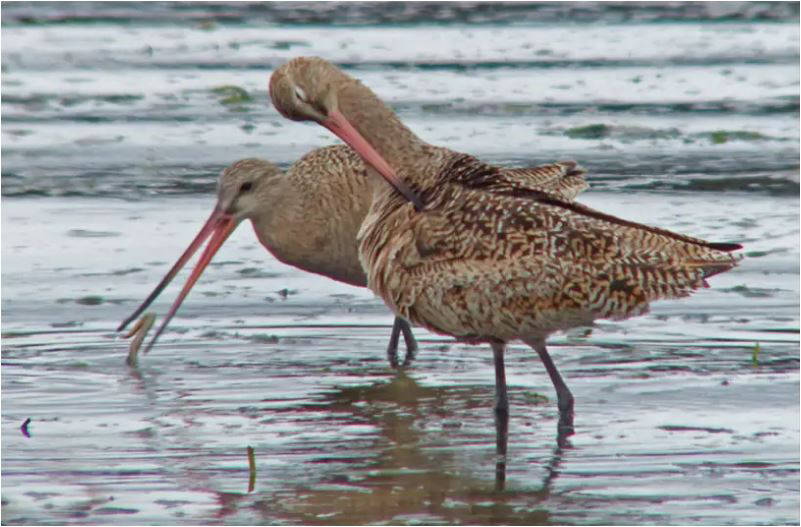By Mary F. Willson
On (yet another) drippy, gray day in late March, I found myself strolling over the tide flats at Eagle Beach, on a moderately low tide. I don’t often go out there, usually preferring the forest edges and meadows, but a friend and I decided to do it, just because it was not my usual thing. It turned out to be more interesting than expected.
Strangely, no geese were evident, although a couple of them were heard in the distance. There were no gangs of crows fossicking in the tide wrack or at the water’s edge. And no gulls but for a lone stray flying overhead. So we watched what was underfoot.
The first thing we noticed was the variation of ripple marks left in the sands. Some were closely spaced and steep-sided; not very far away, others were farther apart and smoother; still others were intricate, swirling patterns of several sorts. That was fun to see, even if we couldn’t explain it.
Soon we came upon a colony of lugworm burrows — dozens of round holes about the size of a dime, just a few inches apart. The tide had washed away the fecal castings the worms often leave around a burrow opening. This colony occupied several square meters. A bit later, we found more such colonies; each one seemed to be on sediments of mixed sand and mud.
[On The Trails: Eagle Beach at equinox time]
One tidal channel had carved deeply into a mudbank, exposing lots of previously-buried clams and dropping some of them into the remaining trickle of water. In certain places, we found ‘graveyards’ of clams, including horse clams and others—thousands of half-shells littered the muddy surfaces near the tidal channels. Most interesting were the intact shells, both valves still connected and the pair of them standing up right, with one end still buried and the other (where the siphon would have emerged) exposed. All those still-vertical, standing-dead specimens were filled with mud.
Burrowing clams dig themselves in by opening the two valves a bit, extending a muscular foot. They may inflate the foot with water, such that it acts as an anchor. They then shut the two valves, making space for water to move in and down along the foot; this loosens the sediments and the whole clam can then descend toward the foot anchor. By doing this repeatedly, they can bury themselves a foot or two deep.
Horse clams are also called gapers, because they cannot completely close their two valves; the shells are often flared around the opening for the siphon, which is not completely retractable. Clam siphons are used for both breathing and feeding. Water is drawn in through the inhalant side, providing oxygen and suspended food particles; on the exhalant side, uneaten food bits and waste products are sent out.
Sometimes tiny pea crabs enter through the siphon and live inside a clam. They scavenge bits of food that the clam “inhaled,” so they might be called minor parasites, but apparently they do relatively little damage. A pair of pea crabs may stay inside, mating and producing offspring. The juveniles can sometimes be found inside a clam, but I presume they eventually get ‘exhaled’ to live adult lives, in another clam.
Clams are broadcast spawners, sending eggs and sperm out into the water. Fertilized eggs hatch, to produce pelagic larvae that swim and drift around for several weeks before they grow a shell and settle down on the mud.
Over on the river, things were somewhat livelier. There were groups of bufflehead, goldeneye, and mallards. A kingfisher perched over a deep channel and dove. An opportunistic raven rejected our small offerings and went down the steep riverbank to look for something better.
A few days later, again on a medium-low tide, I happened to be on the tombolo leading out to Shaman Island. Rocky intertidal areas, even when the tide is not very low, always have more to inspect than the mudflats do—there are more ways to make a living and to hide from predators. Carefully turn over a flat rock and there might be a little chiton and a cluster of tiny sea stars plastered to the underside. On the now-exposed substrate, there might be several small green urchins, maybe a purple ribbon worm, a couple of slender fish (gunnels or pricklebacks, probably) squirming to hide themselves. The next overturned rock might reveal the siphon of a big buried clam and a scattering of tiny hermit crabs huddled into their snail shells. All that, and more, under just two rocks (which were gently replaced in their original position). What a contrast to the visible ‘wildlife’ we’d found on the mudflats!
• Mary F. Willson is a retired professor of ecology.“On The Trails” is a weekly column that appears in the Juneau Empire every Wednesday.

